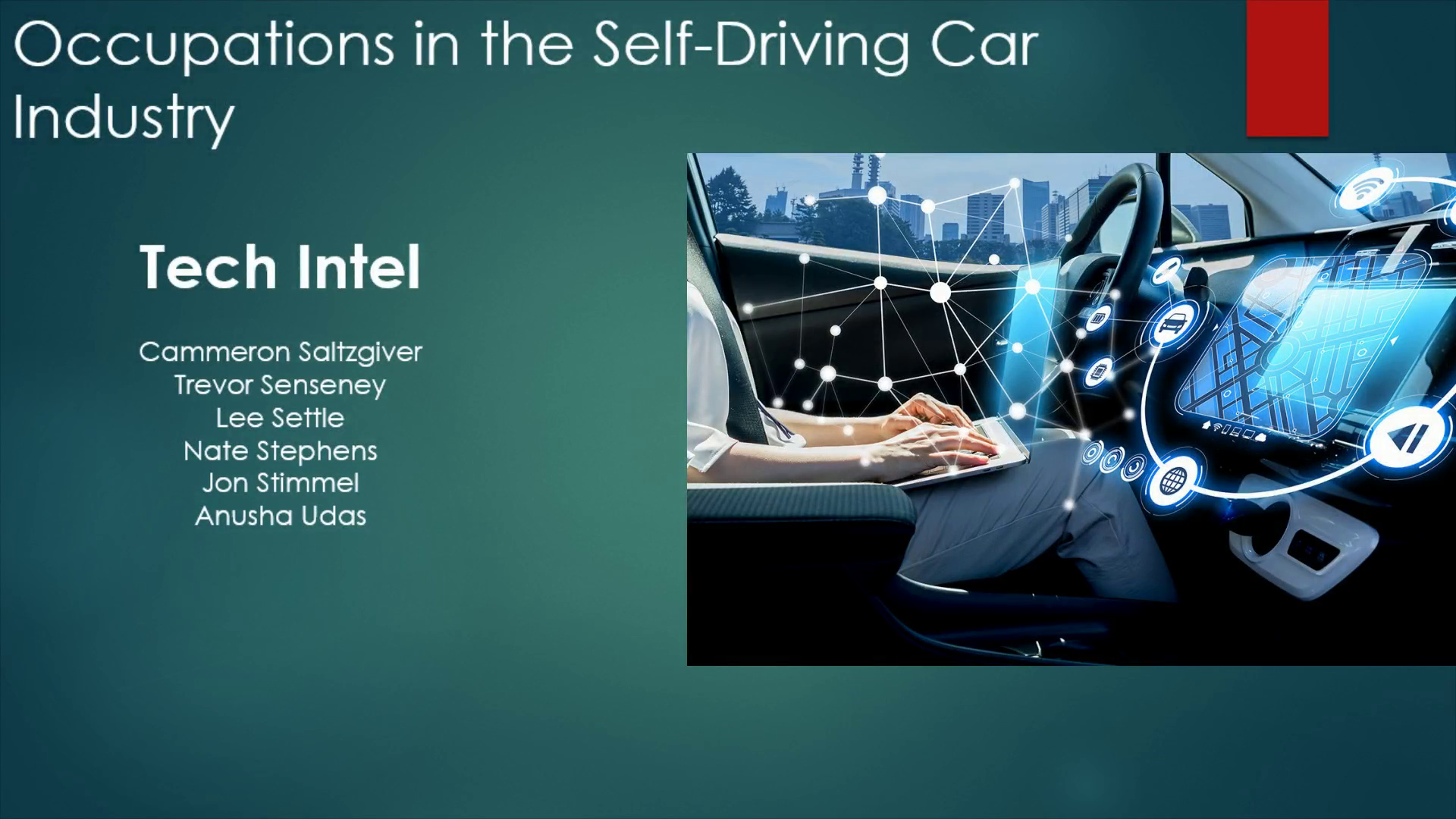
PowerPoint Presentation
Scene 1 (0s)
[Audio] Good Morning, Afternoon, Evening Class and Professor, we will presenting Tech Intel's brief on Self-driving cars. Tech Intel comprises of Cammeron Saltzgiver, Trevor Senseney, Lee Settle, Nate Stephens, Jon Stimmel, and Anusha Udas..
Scene 2 (18s)
[Audio] DARPA Challenges—The U.S. Department of Defense's research arm, DARPA, sponsored a series of challenges that pushed autonomous technologies forward. In 2004, a competition was held to challenge vehicles to self-navigate 150 miles of desert roadway. While no car completed the route, subsequent challenges have seen dramatic leaps in capabilities. The 2007 challenge simulated a 60-mile long urban environment, with four cars completing the route in the allotted six-hour time limit. Tesla Autopilot— The most significant aspect of Tesla's semi-autonomous " Autopilot" feature, introduced in late 2015—which enabled hands-free control for highway and freeway driving— is that it was delivered in the form of a single software update to Model S owners overnight. MCity—The University of Michigan's 32-acre Mobility Transformation Center, called MCity, launched in 2015 as a world-class test facility for autonomous vehicle technology. Ford became the first automaker to test autonomous vehicles there, and in the harshest environmental conditions imaginable. The collaboration between private sector, government, and academia that has already begun to fully integrate autonomous automobiles into our lives is perhaps the most exciting aspect of the dawn of the autonomous vehicle era..
Scene 3 (1m 50s)
[Audio] Waymo, one of many technology companies testing autonomous vehicles in the U.S., now is giving fully autonomous rides, with no backup drivers in certain instances, for ride-hailing customers in the Phoenix suburbs of Chandler and parts of Tempe. The Waymo One service has been offering rides to anyone who downloads the app in their service area since October 2020. Phoenix's sunny weather, lack of freezing temperatures and moisture, relative paucity of pedestrians and wide roads made it an ideal environment for deploying the world's first fully autonomous commercial ride-hail service. It's not the only environment where testing has occurred, though; Waymo has tested in more than 25 locales with differing weather and traffic conditions, including the San Francisco Bay Area, Florida, Washington state and others..
Scene 4 (2m 45s)
[Audio] Much of the rationale for autonomous technology is to reduce the thousands of annual traffic crash deaths in the U.S. Nearly 39,000 people died on American roads in 2020 compared with just over 36,000 deaths in 2019, according to estimates in a May 2021 report from the National Highway Traffic Safety Administration. As traditional efforts to increase road safety, including new laws and enforcement, seem to have stalled, safety advocates and technology boosters hope autonomous technology can make a real dent in traffic fatalities and injuries. ( Shinkle, 2021) People with disabilities, like the blind, are capable of self-sufficiency, and automated vehicles can help them live the life they want. People with different types of disabilities cannot drive due to their disability, with autonomous vehicles, this will be possible for them. Self-driving cars can help avoid the costs of crashes, including medical bills, lost work time and vehicle repair. Fewer crashes may reduce the costs of insurance. In a fully automated vehicle, all occupants could safely pursue more productive or entertaining activities, like responding to email or watching a movie. Autonomous vehicles maintain a safe and consistent distance between vehicles, helping to reduce the number of stop-and-go waves that produce road congestion..
Scene 5 (4m 14s)
Some Occupations That Make It All Happen. Perception Software Engineer Strategic Account Manager Field Service Technician Industrial Engineer.
Scene 6 (4m 34s)
[Audio] This job role offers the challenge of developing cutting-edge tech and machine learning models for self-driving cars. A self-driving vehicle must be aware of objects, stationary or moving around it, and precisely self-navigate around them. This tech relies on a diverse set of sensors like LIDARs, cameras, and radars. Companies like Waymo, Tata and others who are in the autonomous vehicle development industry, require researchers and software engineers to know computer vision and machine learning techniques for perception on self-driving cars. ( Top Jobs In Autonomous Vehicle Industry & How You Can Land Them, 2020) Some of the Responsibilities are: Develop perception algorithms for autonomous systems Integrate perception software into prototype systems Sensor calibration, synchronization and fusion Object recognition and 3D scene reconstruction Target detection and tracking Training of classical machine learning models Qualifications: B. Sc/ Ms/ PhD degree in Electronics Engineering, Electronics and Computer Engineering, Robotics or Computer Science Understanding of ADAS sensors such as radar, camera, ultrasonic, and lidar Excellent knowledge and proven expertise in sensor fusion, probabilistic perception, object tracking, data association, optimization, and/or machine learning High level of proficiency developing in C/C++ / Python Average Salary The average perception engineer salary in the USA is $ 160,000 per year or $ 82.50 per hour. Entry level positions start at $ 125,000 per year while most experienced workers make up to $ 240,000 per year..